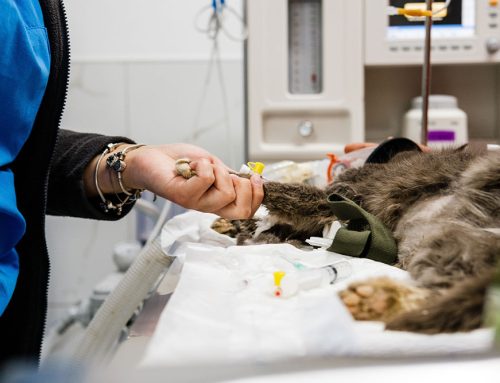Emergency Physical Exam for Pets: Signs Your Dog or Cat Is in Trouble
Pets can’t tell us when something is wrong, which is why it’s essential for owners to recognize the signs of a medical emergency. Some symptoms—such as sudden collapse, severe bleeding, or difficulty breathing—are clear indicators of distress. However, other signs can be more subtle, making it difficult to know when urgent veterinary care is needed.
At Milford Animal Hospital in Milford, PA, we want pet owners to feel confident in assessing their pet’s condition at home while knowing when to seek professional care. This guide will walk you through a basic emergency physical exam and help you determine when a trip to the vet is necessary.
What to Do First in a Pet Emergency
If you suspect your pet is in distress, follow these steps before performing an exam:
- Stay calm. Panicking can make it harder to assess the situation clearly.
- Ensure your safety. Injured or sick pets may bite out of fear or pain. Approach cautiously.
- Move your pet carefully. If they are in a dangerous location (e.g., a roadway), gently move them to a safer area.
- Check for immediate danger signs. If your pet is unconscious, bleeding heavily, or struggling to breathe, seek emergency veterinary care immediately.
- Contact your veterinarian. Call Milford Animal Hospital for guidance on next steps.
For a step-by-step guide to evaluating a sick dog at home, visit The Humane Society’s home exam guide.
Emergency Physical Exam: What to Check
If your pet is showing unusual behavior or signs of distress, performing a quick physical assessment can help determine whether they need immediate veterinary attention.
Check Their Breathing
- Normal breathing: Smooth and unlabored, 15–30 breaths per minute (dogs), 20–40 breaths per minute (cats).
- Emergency signs:
- Open-mouth breathing in cats (always abnormal).
- Wheezing, choking, or gasping.
- Heavy panting that does not stop with rest.
Examine the Gums and Mucous Membranes
Healthy gums should be pink and moist. Lift your pet’s lip and press on the gums—color should return within 1–2 seconds after releasing.
- Pale or white gums → Possible shock, blood loss, or anemia.
- Blue or gray gums → Indicates oxygen deprivation—seek emergency care immediately.
- Bright red gums → Could signal heatstroke, toxicity, or inflammation.
Take Their Pulse
- Normal heart rates:
- Dogs: 60–140 beats per minute (varies by size).
- Cats: 140–220 beats per minute.
- Check the pulse by placing fingers inside the hind leg’s inner thigh or over the chest near the left elbow.
- Emergency signs:
- Weak or irregular pulse.
- Heart rate too fast or too slow.
- No detectable pulse—seek immediate care.
For a step-by-step guide on performing a DIY dog checkup, visit Kinship’s pet health guide.
Assess Their Body Temperature
- Normal temperature: 5–102.5°F (dogs and cats).
- Use a digital rectal thermometer for the most accurate reading- only perform this if you have help holding your pet, and can be sure your pet will not bite.
- Emergency signs:
- Below 99°F → Could indicate shock or hypothermia.
- Above 103.5°F → Suggests heatstroke or infection.
Look for Signs of Pain or Weakness
- Stiffness, reluctance to move, or limping → May indicate injury or arthritis.
- Shaking or trembling → Can be due to pain, fever, or stress.
- Sudden collapse or inability to stand → Seek emergency care immediately.
Check for Vomiting, Diarrhea, or Bloating
- Mild vomiting or diarrhea → May be due to dietary indiscretion but should improve within 24 hours.
- Repeated vomiting or bloody stool → Could indicate toxicity, infection, or gastrointestinal disease.
- Swollen or hard abdomen → May signal bloat (GDV) in dogs, which is life-threatening.
For a list of emergencies that require immediate care, review AVMA’s guide to pet emergencies.
When to Seek Emergency Veterinary Care
Immediate Emergencies – Go to the Vet NOW
- Difficulty breathing, choking, or collapsed
- Seizures lasting more than 2 minutes
- Severe trauma (hit by a car, fall from height)
- Profuse bleeding that won’t stop
- Ingestion of toxic substances (chocolate, antifreeze, medications, toxic plants)
- Bloated or hard abdomen, especially with restlessness and drooling
For more information on how to recognize pet emergencies, visit AAHA’s emergency care guide.
Urgent – Call Your Vet Immediately
- Persistent vomiting or diarrhea for more than 24 hours
- Sudden lethargy, weakness, or extreme fatigue
- Difficulty urinating, especially in male cats (can indicate a life-threatening urinary blockage)
- Signs of eye injury (swelling, redness, excessive discharge)
- Lameness or suspected broken bones
Monitor at Home – Call If Symptoms Persist
- Occasional coughing or sneezing (without other signs of illness)
- Mild limping that improves with rest
- A single episode of vomiting after eating too fast
- Temporary lack of appetite (unless lasting more than 24 hours)
Be Prepared: Pet First Aid and Emergency Readiness
Emergencies can happen at any time, so it’s essential to be prepared.
Take a Pet First Aid Course
Consider enrolling in a cat and dog first aid class through the American Red Cross.
Have an Emergency Kit Ready
Include:
- Gauze, bandages, antiseptic wipes
- Digital thermometer
- Hydrogen peroxide (only for inducing vomiting under veterinary guidance)
- Emergency vet contact numbers
Know Where to Go for Emergency Care
Locate your nearest 24-hour emergency vet clinic in advance.
Contact Us for Emergency or Preventive Care
Early detection of health problems can save lives. If you are unsure whether your pet needs emergency care, it’s always best to call.
Need emergency advice? Contact Milford Animal Hospital for immediate guidance.
Want to schedule a wellness exam? Book an appointment to stay ahead of potential health issues.








Leave A Comment